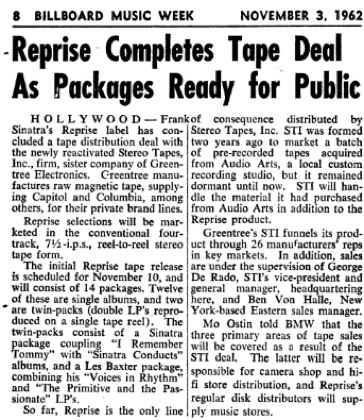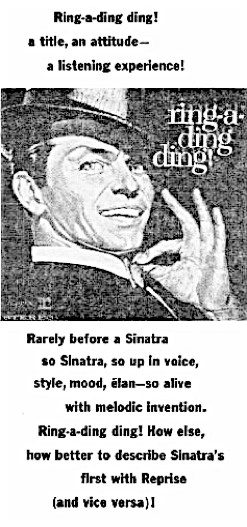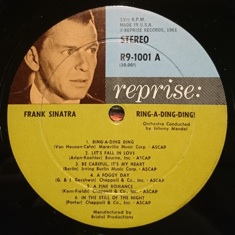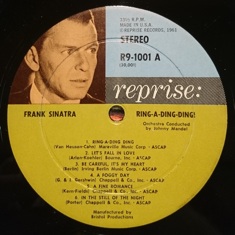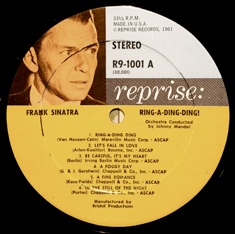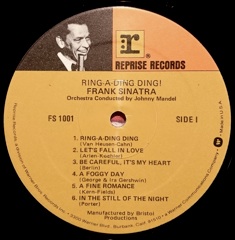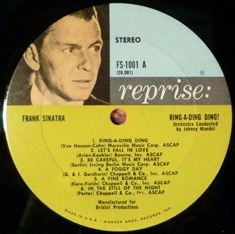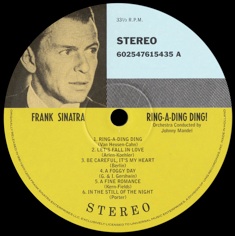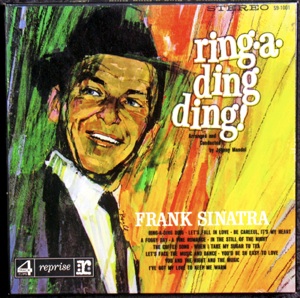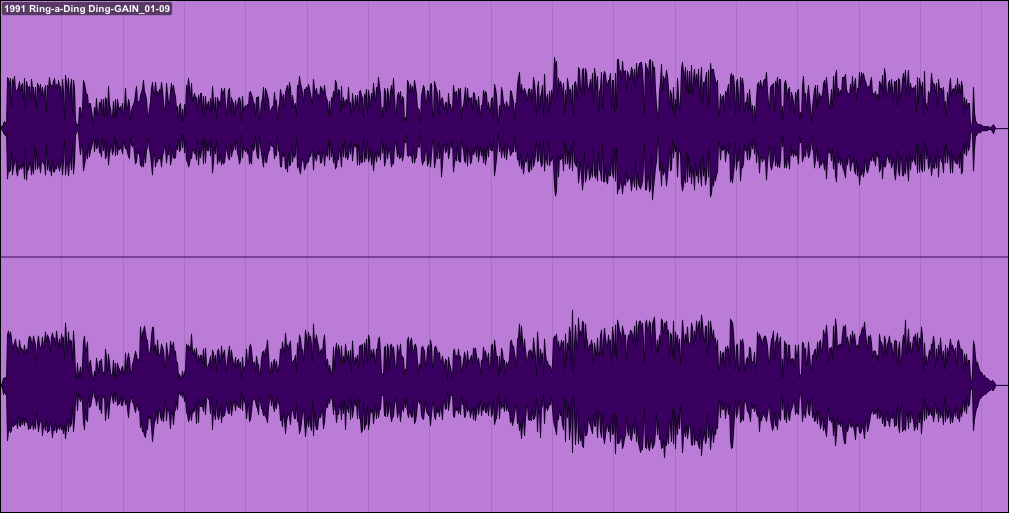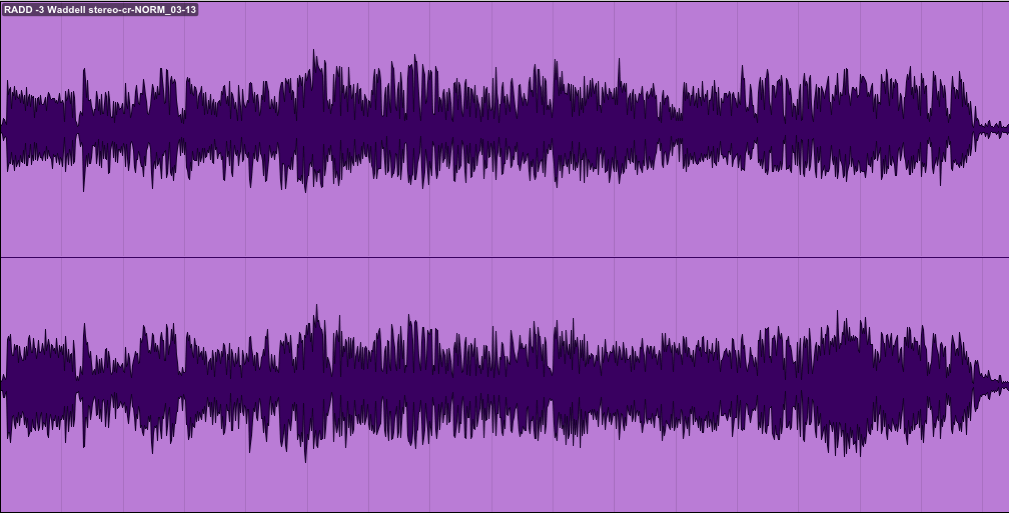Ring-a-Ding Ding - 1961
Different studio. Different engineer. Different 3-track EQ (more on that later). Different arranger/conductor. Felix Slatkin, a trusted friend, in the producer’s chair. Different record company. Sinatra still very much in charge of the session, and now the owner of the record company.
Familiar U-47 vocal microphone. Cream-of-the-crop LA musicians, still recording to 3-track tape (and other formats), with Sinatra right out there on the floor, in the thick of things -- some things old; some things new, with an excitement in the air that comes through the recording.
Sinatra recording at United for Reprise, album #1. Where to start?
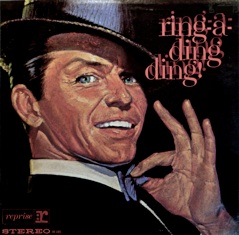
recording dates
December 19-21, 1960
Producer
Felix Slatkin
(uncredited)
ArrangerS
Johnny Mandel, Dick Reynolds, Skip Martin
Conductor
Johnny Mandel
ReCORDING ENGINEER
Eddie Brackett,
United Recording
Release date
April 3, 1961

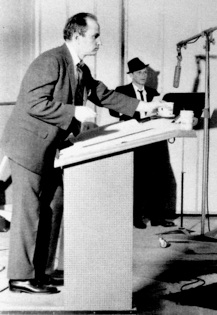
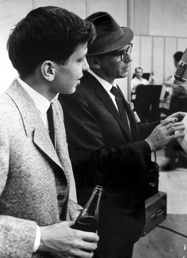
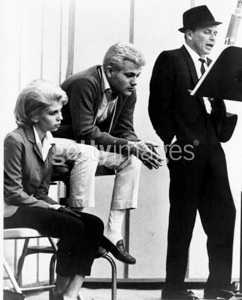
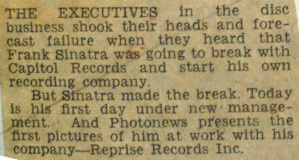
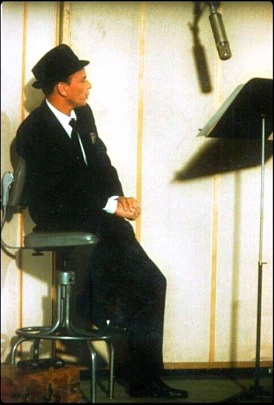
Initial sessions at United, December, 1961.
Mono Mixes
There were two mono mixes released, neither of them award-winning, and mono mix #2 is merely a fold-down of stereo mix #2, not a dedicated mono mix. Audio clips below. (All clips mirror the segments freely available via iTunes. Itunes samples available at right.)
ABOVE: USA R-1001 mono LP, pressed by Waddell, -3 in runout. MONO MIX #1. (This particular LP came from the library of KJR radio in Seattle.)
ABOVE: UK R-1001 mono LP, pressed by Pye Records. MONO MIX #1.
AT LEFT: Later USA F-1001 mono LP, mastered and pressed at Columbia, 1E stamped in runout. MONO “MIX” #2 (which is a fold-down of stereo mix #2).
Stereo Mixes
While only one genuine mono mix was ever created, as many as five different stereo mixes exist: 1961 and 1962 (or maybe even as early as September of 1961) for LP; 1991 (there is some debate -- remix, or new mastering of mix #1?), possibly 1998 (another point of ongoing discussion -- remix, or remastering of “mix #3?”), and 2011 for CD. (The 2011 CD remix was re-used a few years later for an LP reissue.)
The original stereo mix was only available for a brief time, quickly replaced by mix #2, making this the only album to receive a stereo remix during the early, pre-Warner Bros. history of Reprise Records. Here are some general characteristics of the mixes:
•Mix #1 (1960 or 1961): Strings on the right -- very likely an error, as strings are traditionally on the left. Tasteful amounts of chamber reverb used.
•Mix #2 (Late 1961?): Strings moved (correctively?) to the left; unnatural, slapback reverb (nearly Elvis-style, but used more subtly) on the vocal. This was the common stereo mix from about 1962-1990, through “The Reprise Collection” CD release.
•Mix #3 (?): (Is this even a remix? I am not sure.) Very similar to Mix #1, but with generally better tone. As with mix #1, which this appears to model itself after, strings are (incorrectly?) on the right, and the reverb usage is very tasteful.
•Mix #4 (?): (Is this even a remix? I think so, but wouldn’t swear to it.) Same left/right layout as #1 and #3, but with far more tweaking/processing.
•Mix #5: Again, the same left/right layout as #1, #3, and #4 (strings on the right), but with a dry vocal presentation, i.e., little or no reverb.
STEREO LP
RELEASES

All samples on this page correspond to freely-available audio samples accessible through iTunes.

All samples on this page correspond to freely-available audio samples accessible through iTunes.
ABOVE: 1991 Reprise CD. STEREO MIX #3????? Or original mix?? (Reused in the Reprise “suitcase” set.) Mixed (?) and mastered by Lee Herschberg.
ABOVE: 1998 Reprise EOTC CD. STEREO MIX #4 (??). Mastered by Keith Blake.
ABOVE: 2011 Reprise EOTC CD. STEREO MIX “#5.” Mixed and mastered by Larry Walsh.
ABOVE: Italy-pressed mono LP, courtesy SH.TV member “Roda12.” (19-9-61 in runout may indicate date of lacquer cut.) MONO “MIX” #2 (which is a fold-down of stereo mix #2).
Here is a clip that begins with the original-mix “-3” LP, transitions to the later Columbia-pressed LP (remix), then back again: https://app.box.com/s/poqi8cqvvextsmh7lsctbkgpb1xrnbm0
To my ears, both of these mixes, at least as mastered for LP, get the “two thumbs way down” response. The first mix can be improved somewhat by some pretty major EQ adjustments, but there’s only so much to be gained, in my experience, and eventually the point comes where it sounds “goosed” or faked up.
Oddly, there is a bootleg release of outtakes from this album, all in mono, and the sound quality is splendid!
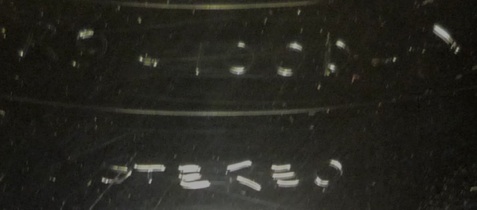
ABOVE: USA R9-1001 stereo LP, likely mastered by Ami Hadani, pressed by Waddell, -A2 in runout. STEREO MIX #1.
ABOVE: USA R9-1001 stereo LP, likely mastered by Ami Hadani, pressed by Waddell, -3 in runout. STEREO MIX #1.
ABOVE: USA R9-1001 stereo LP, likely mastered by Ami Hadani, pressed by Waddell, -12 in runout. STEREO MIX #2.
ABOVE: Mid-60s USA FS-1001 stereo LP, mastered and pressed by Columbia, -1E in runout. STEREO MIX #2. Audio and photo courtesy SHTV’s “MMM.”
ABOVE: Circa 1986 USA FS-1001 stereo LP, mastered at Warner Brothers, plated at Capitol’s Winchester plant, and pressed by Specialty under contract to Capitol, -WW1 in runout. STEREO MIX #2. Audio courtesy SHTV’s “Dasacco.”
ABOVE: German FS-1001 stereo LP. STEREO MIX #2.
ABOVE: 2016 UMe stereo LP, STEREO MIX #5. Audio and photo courtesy SHTV’s “BFerr1.”
CLICK PHOTOS TO HEAR AUDIO CLIPS.
REEL-TO-REEL RELEASES CLICK COVER PHOTOS TO HEAR AUDIO CLIPS.



ABOVE: Original, briefly-available Ampex-manufactured RSL-1701 7.5 IPS stereo reel-to-reel tape. STEREO MIX #1.
ABOVE: Later (introduced to the market November 10, 1962), alternate-cover, Stereotape-manufactured S9-1001 7.5 IPS stereo reel-to-reel tape. STEREO MIX #2. Audio and photo courtesy SHTV’s “MMM,” dubbed on the same Tandberg machine as the RSL-1701 clip.
COMPACT DISC RELEASES CLICK COVER PHOTOS TO HEAR AUDIO CLIPS.
Please continue to page 3, conclusions.
Regarding the “alternate cover” reel-to-reel release: There’s an odd “rumble” going on in the right channel during “When I Take My Sugar to Tea” and “You and the Night and the Music.” I don’t hear it on the stereo or mono LP pressings that I checked, which makes me wonder if maybe the low frequencies were cut somewhat during the LP cutting process, eliminating these sounds.
The alternate-cover reel was issued on November 10, 1962, according to Billboard:
